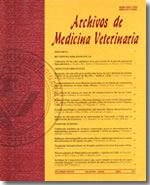Symbiotic relationship between udonella sp. (monogenea) and caligus rogercresseyi (copepoda), a parasite of the chilean rock cod eleginops maclovinus
Main Article Content
Abstract
This paper studies the host-parasite relationship between the worm Udonella sp. (Monogenea) found on the genital segment of the sea lice Caligus rogercresseyi (Copepoda), a common parasite of the rock cod Eleginops maclovinus found off the coast of southern Chile. The biological association between these invertebrates is interesting because C. rogercresseyi also infects farmed salmon (Boxshall and Bravo, 2000) and eventually Udonella sp. could be used for the biological control of sea lice. Rock cod were captured with hook and line and examined in the laboratory for lice, selecting only those C. rogercresseyi ovigerous females with Udonella sp. A video camera placed on a stereomicroscope was used for the in vitro observation of worms on the copepods on which they survive. Egg strings of copepod females with Udonella were later fixed in buffered formalin at 5% and stained with hematoxylin-eosin and prepared for histological sections of the structures involved in host-parasite attachment. For histochemical analysis toluidine blue at different pH levels was used. Observations with hematoxilin _ eosin showed that the external cuticle of the egg sac is acidofilic and remains undamaged while Udonella adhesive disc is attached. When toluidine blue was used, the attachment area showed slight basophylic stains and metachromasia visible at pH of 1.2. Udonella at the caudal gland level as well as C. rogercresseyi at the sub-cuticular region of the egg sacs showed basophylic reaction at pH of 4.5. The present paper clarify the absence of possible mechanical damage in the parasite-host attachment site and provides an histological description of the wall dependent contact points between Udonella - Caligus plus the extracellular space that separates them. Udonella survived on mucus secreted by the rock cod's skin and not on the content of the copepod's egg sacs, which serve more as an attachment area given that in this zone what is seen is a metachromatic stained strip corresponding to acid glycosaminoglycans (Aranishi & Nakane, 1998; Buchmann, 1998). The association between the worm and the copepod is commensalistic.

